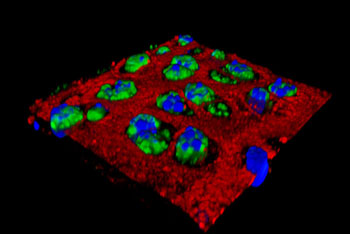RNA-Based Therapy Reverses Cartilage Damage in Osteoarthritis
By LabMedica International staff writers
Posted on 19 Oct 2016
A novel treatment for osteoarthritis (OA) is based on a nanoparticle delivery system that transports a specific anti-inflammatory siRNA (short interfering RNA) to the chondrocytes in damaged cartilage.Posted on 19 Oct 2016
Osteoarthritis is a common debilitating joint disease for which there are few therapeutic options. Critical barriers to the successful development of osteoarthritis treatment include limited understanding of the pathways governing early cartilage degradation and ineffective delivery of therapeutic agents to the resident chondrocytes in the avascular cartilage.

Image: Researchers have found that injecting nanoparticles into an injured joint can inhibit the inflammation that contributes to the cartilage damage seen in osteoarthritis. Shown in green is an inflammatory protein in cartilage cells. After nanoparticles are injected, the inflammation is greatly reduced (Photo courtesy of the Pham Laboratory, Washington University School of Medicine).
A new treatment approach for OA has been developed by investigators at Washington University School of Medicine (St. Louis, MO, USA). They fabricated nanoparticles containing the peptide melittin bound to an siRNA that specifically suppressed the inflammatory factor NF-kappaB.
The investigators reported in the September 28, 2016, online edition of the journal Proceedings of the [U.S] National Academy of Sciences that a murine model of controlled knee joint impact injury allowed them to examine cartilage responses to injury at specific time points. They used this model to show that delivery of peptidic nanoparticles complexed to NF-kappaB siRNA significantly reduced early chondrocyte apoptosis and reactive synovitis.
The peptide–siRNA nanocomplexes were found to be nonimmunogenic, were freely and deeply penetrant to human OA cartilage, and persisted in chondrocytes for at least two weeks. The peptide–siRNA platform thus provided a clinically relevant and promising approach to overcoming the obstacles of drug delivery to the highly inaccessible chondrocytes.
“I see a lot of patients with osteoarthritis, and there is really no treatment,” said senior author Dr. Christine Pham, associate professor of medicine at Washington University School of Medicine. “We try to treat their symptoms, but even when we inject steroids into an arthritic joint, the drug only remains for up to a few hours, and then it’s cleared. These nanoparticles remain in the joint longer and help prevent cartilage degeneration.”
Related Links:
Washington University School of Medicine












